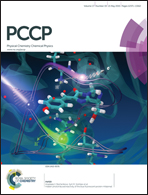Evidence of monolayer formation via diazonium grafting with a radical scavenger: electrochemical, AFM and XPS monitoring†
Abstract
This paper analyzes the impact of the use of a radical scavenger on organic films generated by aryldiazonium electrografting in terms of thickness, morphology and chemical composition. Glassy carbon (GC) and pyrolyzed photoresist films (PPFs) were modified by electrochemical reduction of 4-nitrobenzenediazonium salt in the presence of various amounts of 2,2-diphenyl-1-picrylhydrazyl (DPPH). The thicknesses of the organic films have been measured by atomic force microscopy (AFM) and the lower threshold values confirm that it is possible to reach a monolayer by radical trapping. X-ray photoelectron spectroscopy (XPS) highlights a decrease in the proportion of nitrophenyl groups grafted via azo bridges as the DPPH concentration decreases and the film thickness increases. A correlation of electrochemical, XPS and AFM data confirms that not all nitrophenyl groups are electroactive in films greater than 2 nm thick.


 Please wait while we load your content...
Please wait while we load your content...